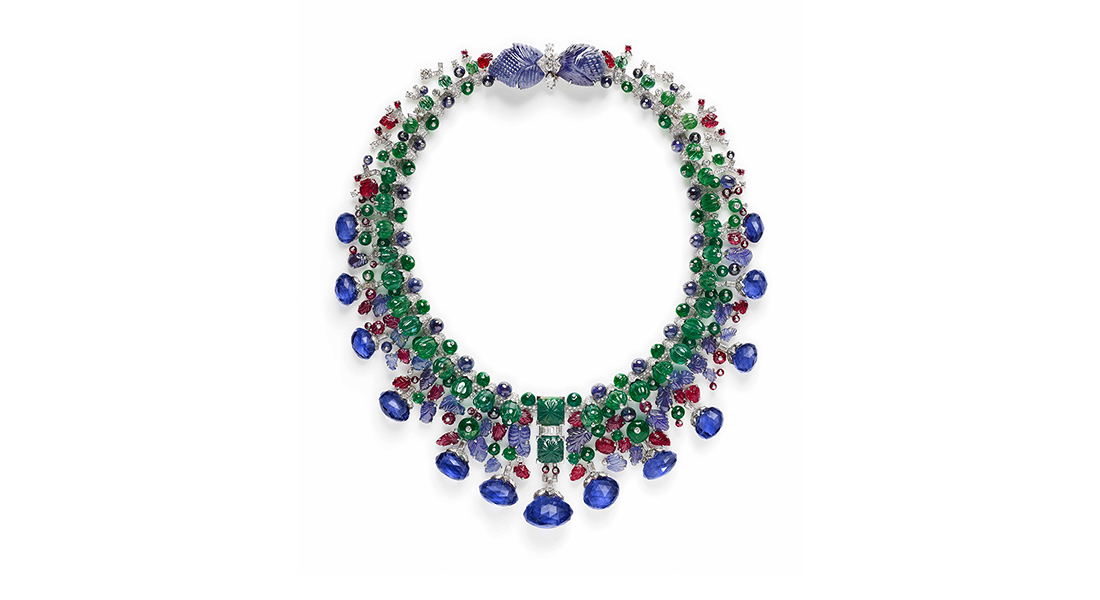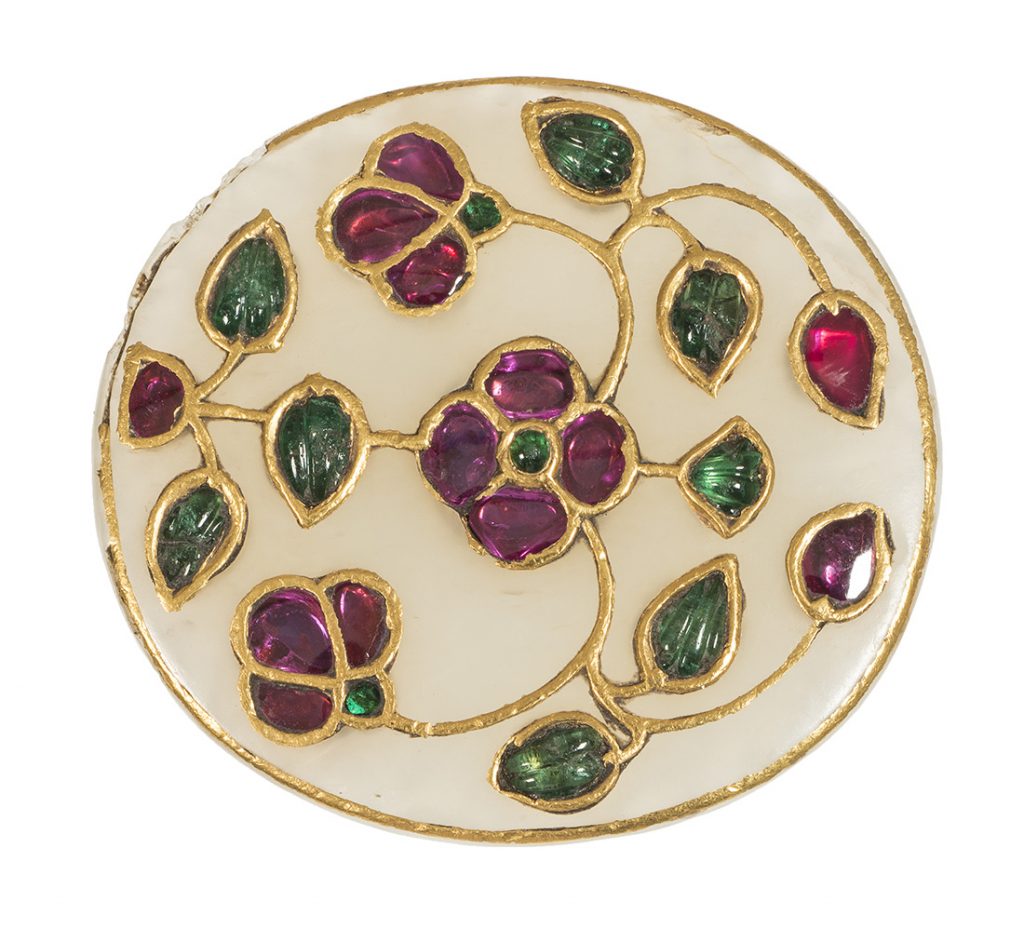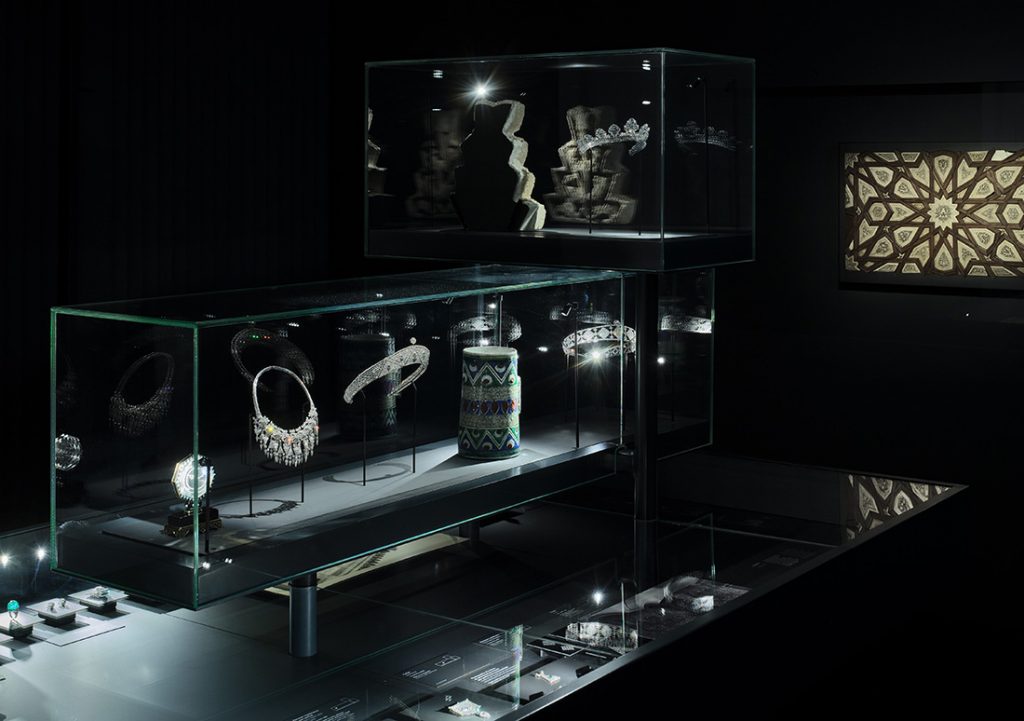India is front and centre at this exhibition. And its contribution to the house of Cartier, whilst somewhat obscured by the exhibition’s title, is made clear by the gorgeous pieces on display and the stories told around them.
There is a near constant line that wraps around the Louvre Museum complex in Paris for the new jewellery exhibition “Cartier and Islamic Art: In Search of Modernity” that will run until February 20, 2022.
One of the biggest draws inside this spectacular show of 500 display items in the Musée des Arts Decoratifs (MAD) venue, Paris, is the plethora of Indian artefacts.
Helping tell the India part of the story are all kinds of display items. This includes black-and-white photos commissioned, as was the custom, for a trip made by Jacques Cartier to India in 1911. The trip was pivotal in Cartier’s subsequent adaptation of Indian design and jewellery-making techniques. Here’s how:
Prompting Jacques Cartier’s trip to India in 1911 was the coronation of King George V and Queen Mary in December of that year. Cartier set out by ship in October from Marseille, hoping to take advantage of the event to connect to Maharajas, and to find direct suppliers for Indian gemstones.
He made other discoveries along the way, including antique and contemporary Indian jewellery.
Upon his return in April 1912, he organised an exhibition in Cartier’s store in London “Jewels and Objects D’Art Recently Collected in India.”
It was on this trip that he met with the maharajas, and started buying and collecting original Indian jewellery, not to mention researching suppliers for precious stones and pearls, which accounted for a large part of the house’s business in the 1920s.
Musée des Arts Décoratifs, Paris © MAD, Paris / Jean Tholance
He organised three more exhibitions. One in Paris in June 1913, and one each in New York and Boston in November 1913. These displayed Cartier pieces inspired by India marked the beginnings of Art Deco.
Artefacts on display from these exhibitions/era are few at the current show in Paris. They include an Indian style brooch shown in Cartier’s New York store in 1913. It is made of platinum, pearls, diamonds, onyx, and emeralds.
There is one necklace included that is similar to one shown in the 1913 exhibition. It is an 18th century Santari, or seven-stranded necklace piece, from Hyderabad and is made of gold, enamel, pearls, and rock crystal. The only original piece from the 1913 show was restored by the Maison Cartier Workshop. It’s the only piece that could be located from the show, and consists of gold, smoked rock crystal, emeralds, rubies, jade, pearls, and enamel. The workshop made the clasp into a pendant and re-strung the beads.

“The Indian influence on Cartier was very important at the beginning of the 20th Century for the trade of precious stones and the buying of ‘apprêts’ or artefacts,” Evelyne Possémé, Chief Curator of Ancient and Modern Jewellery at Musée des Arts Decoratifs, and one of four curators of the show, tells Solitaire International. “Then with the (India) exhibition in 1912-1913 by Cartier, it kept Indian apprêts in stock. The Indian influence was very important in the Art Déco period with its maharajah customers. In the 30s, Indian fashion was so important that Cartier imported Indian jewellery to sell in Europe. They dismantled and reconstructed Indian jewellery in a new way to create modern jewellery in the Indian style until the end of the 1940s.”
A quote from Jacques Cartier on the wall in the India section of the exhibition reads: “If I have understood my mission, my most important task on my trip to India is to investigate the pearl market and determine the best way for us to source them.”
There is only one original piece on display from the exhibitions that he staged and one piece similar to an original. The other original exhibition items from the Paris show are documented in a photo display that hangs on one wall.
The Cartier and Islamic Art show includes around 69 pieces from India, including documents, photographs, and jewellery.
“All are very different. Some [of it] is Indian jewellery bought and sold by Cartier. Some are Indian artefacts used by Cartier in their jewellery … Some are photographs from Indian monuments seen by Jacques Cartier on his travels, and some are photographs of the Indian jewellery exhibited in the 1912 London or 1913 Paris exhibitions in the Cartier shop about Oriental jewellery,” explains Possémé.
India rubs shoulders with Iran in the exhibition, and for several display pieces, it’s unclear if the origin is India or Iran. Where the origin is known to be India or Iran, this information is provided. One example is a court belt on display from the 17th century in silk and silver thread. Belonging to the Louvre, the piece is identified as being from India or Iran.
“With Iran, India was one of the most important sources of inspiration for Cartier in the large part of the 20th century,” adds Posseme.
We learn more about India’s role at Cartier in the written documentation to the show. “In the 1930s, under the artistic direction of Jean Toussaint, Cartier’s style gave way to new shapes and colour combinations, inspired mainly by India. Tutti Frutti pieces, sautoirs, and voluminous jewellery characterised their highly recognisable style for the second half of the 20th century,” says the accompanying press material.
Catalogues from the Cartier archives are also on show. This includes the Cartier department of pearls catalogue from its New York shop from 1922 and, from Cartier’s November 2013 show, “the catalogue of Jewels Created by Messieurs Cartier…from the Hindoo, Arab, Persian, Russian and Chinese on view at 712-5th Avenue, NY.”
In the section Oriental Jewels: New Forms and Technical Innovations, the focus is on how Oriental jewels, principally from India, inspired Cartier design. This included bazubands or beaded jewellery for the upper arms, egrets, tassels, and sunray bib style necklaces.
“The flexibility of Indian jewellery made with techniques of stringing elements on wire-inspired technical innovations at Cartier where designers adapted Indian methodologies to their own platinum mounts, attaching elements so as to confer an extraordinary suppleness to the jewels. Indian stone-cutting techniques including half beads, melon-cut beads, polished raw stones and gemstones, carved to resemble leaves and flowers, were all added to the Cartier repertoire,” it reads.
Louis Cartier’s interest in Oriental art, as per the exhibition, began with a Munich exhibition of Islamic art in 1910, and continued with an abundance of Indian and Persian art hitting the Paris art market from 1906 to 1910.
Cartier & Islam includes 500 display pieces, including sparkling Cartier jewellery, art from the adjacent the Louvre Museum, drawings, books, and archives that illustrate Cartier’s interest in oriental motifs.
Running down both sides of the main hall at MAD, the exhibition is divided into two parts. The first follows the origins of this interest in Islamic art. The second shows the lexicon of forms inspired by Islamic art.
Large screens hanging in the spacious hallway in between the two sections, show some of the finest jewellery blown up and in close up. These were created by Elizabeth Diller of the DS &R Studio.
It’s not the first time the Louvre complex has looked at Islam. It has had an Islamic art gallery since 2012. The exhibition moves to the Dallas Museum of Art from 14 May – 18 September 2022.



